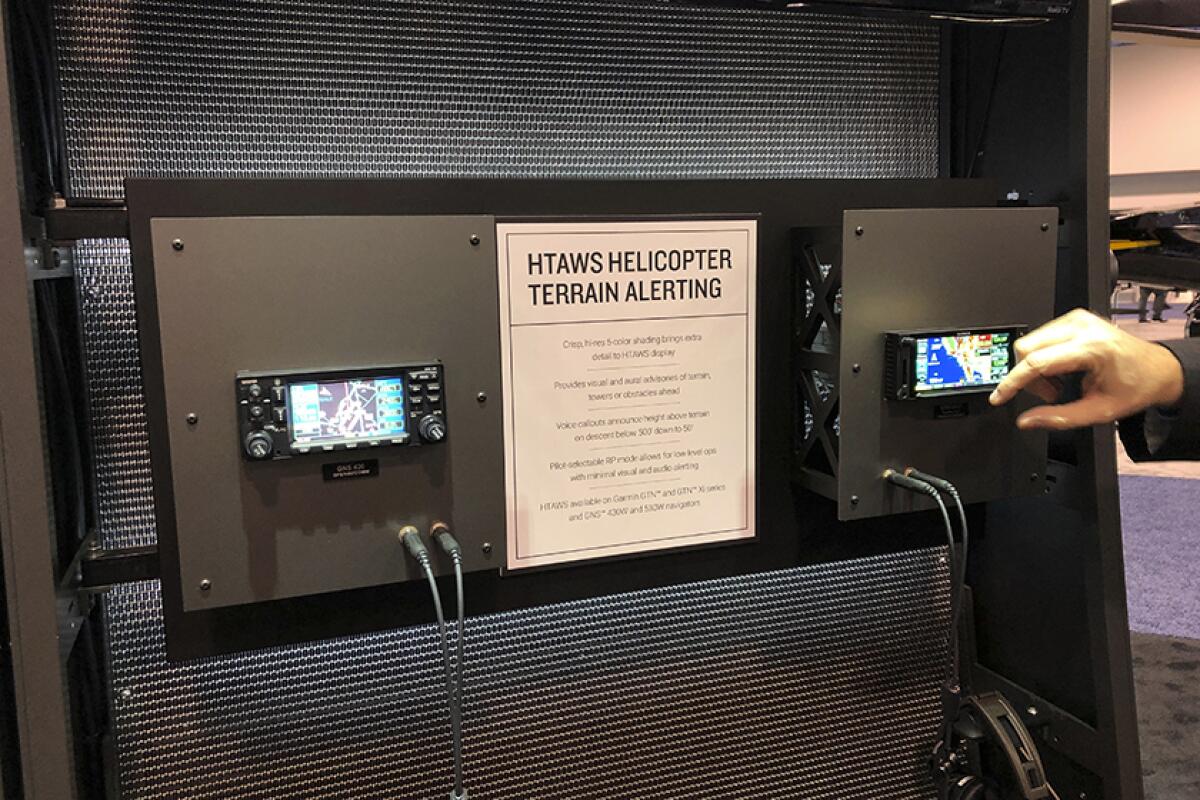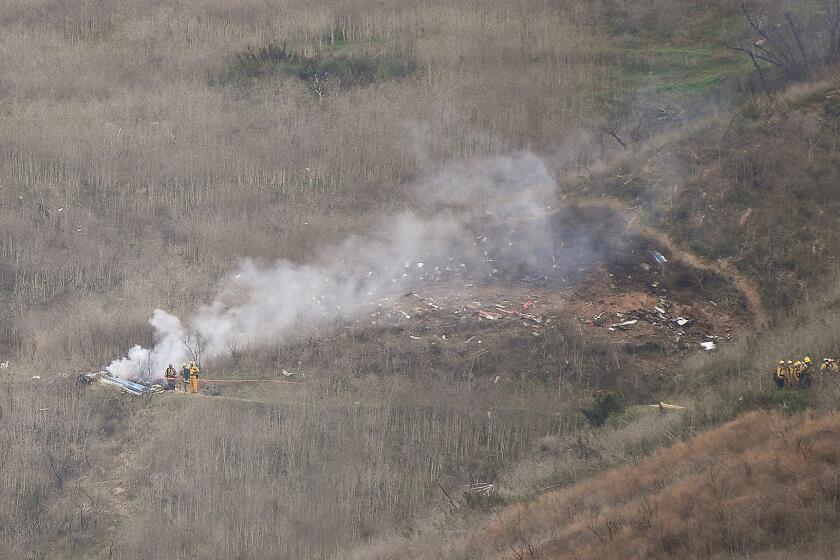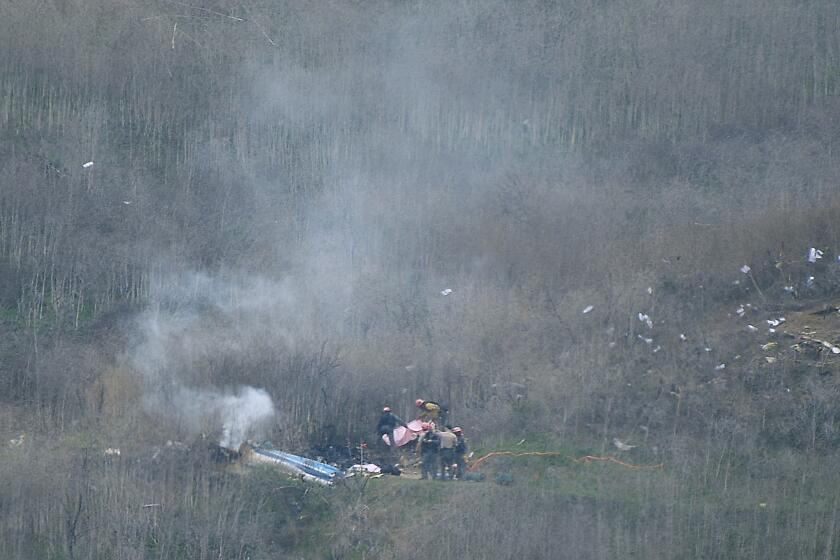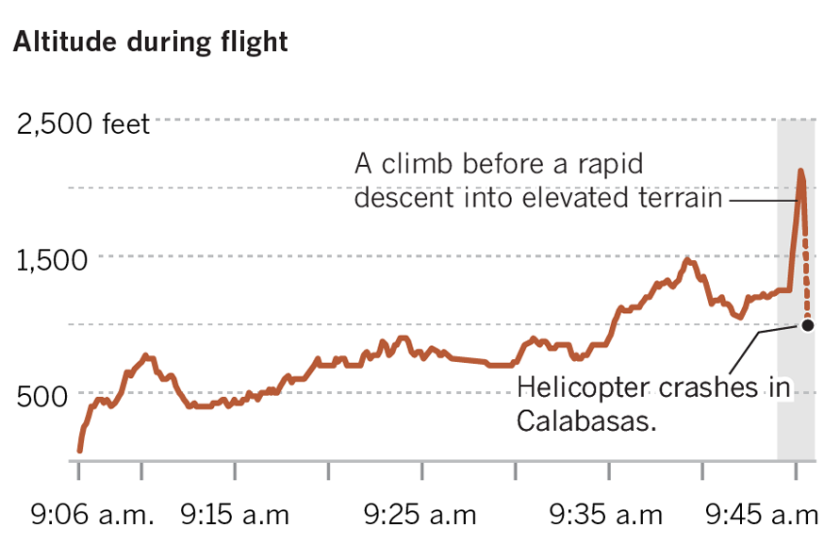Kobe Bryant’s helicopter didn’t have terrain alert system. Could it have averted tragedy?

- Share via
Should helicopters like the one in which Kobe Bryant perished be required to have warning systems that alert pilots when they are flying dangerously close to the ground?
It’s a question that has divided federal regulators for years and is receiving new scrutiny in the wake of the crash that killed the NBA great and eight others in Calabasas.
Their helicopter was traveling in foggy conditions Sunday when it slammed into a hillside. Shortly before, the pilot unsuccessfully sought navigation help from air traffic controllers because of poor visibility.
It is not clear that a terrain awareness and warning system, or TAWS, would have prevented the wreck, but National Transportation Safety Board investigators probing the crash’s cause have drawn attention to the chopper’s lack of a warning system.
“Certainly, TAWS could have helped to provide information to the pilot on what terrain the pilot was flying in,” NTSB board member Jennifer Homendy told a press conference Tuesday.
Complete coverage of the death of Kobe Bryant, his daughter, Gianna, and seven others in a helicopter crash.
The NTSB has argued for a decade and a half that the systems prevent crashes and should be mandatory in helicopters that can accommodate six or more passengers, such as the Sikorsky S-76 that carried Bryant, his 13-year-old daughter, Gianna, and seven others.
But its efforts have been turned aside by another government agency, the Federal Aviation Administration, which sets rules for aircraft.
The NTSB began pushing for a TAWS requirement after a 2004 helicopter crash into the Gulf of Mexico that killed 10.
That crash involved a Sikorsky model very similar to the one in which Bryant and his co-passengers died. According to the board, the two pilots were flying on a “dark night” and failed to recognize their descent and correct it, resulting in a “controlled flight” into the ocean. During the investigation, the NTSB concluded that TAWS could have alerted the pilots to the waters below, giving them time to avoid the fatal plunge and “save the lives of all aboard.”
A Calabasas resident’s front-porch camera seems to have captured audio of the helicopter crash that killed Kobe Bryant.
A subsequent board review of 55 previous helicopter and plane crashes determined that 17 of them might have been prevented by TAWS.
In 2000, the FAA required airplanes carrying six or more passengers to be outfitted with TAWS. At the time, the technology wasn’t workable on helicopters, but had improved enough by 2006 to be required on those aircraft as well, the NTSB said.
Some in the aviation industry balked at requiring TAWS, saying that the technology was mostly unproven.
In comments submitted to the FAA in response to one proposal, some criticized the system as a “distraction in the cockpit” that “doesn’t give the pilot the ability to see/avoid bad weather.” Cost was also an issue. The systems can run $35,000, with operators losing additional revenue during the installation process.
Federal investigators on Monday began an intense investigation into the cause of the Calabasas helicopter crash that killed all nine on board including Kobe Bryant.
The FAA made TAWS mandatory for air ambulances in 2014, but the system remains voluntary in commercial helicopters. NTSB called the decision “unacceptable.”
The FAA said in a prepared statement that commercial helicopters operate in populated areas “relying on a robust network of routes and landing facilities.” The agency said safety improvements unrelated to new rules, like increased automation, have contributed to the U.S. helicopter fatality rate dropping by half over the past two decades, from 1.27 to 0.63 fatal accidents per 100,000 flights.
Sikorsky has voluntarily installed TAWS in its helicopters manufactured since 2005 and has offered retrofit programs. The 1991 chopper Bryant flew in did not have the upgrade.
In flying circles this week, there was much discussion whether the system might have saved one of the world’s best-known athletes.
Among the impediments as investigators seek to determine the cause of the crash are the wide debris field and the lack of a black box recording.
Ronald Goldman, an attorney whose firm has represented victims in helicopter crashes, said that from studying what is publicly available about the flight of Bryant’s chopper, he doubts TAWS would have made a difference.
If the cause was “spatial disorientation” — a phenomenon in which a pilot loses his sense of direction — “TAWS doesn’t tell you up from down,” Goldman said. “It doesn’t tell you which way the ground is.”
Greg Feith, a former senior air safety investigator for the National Transportation Safety Board, said it was hard to know at this point whether TAWS could have helped.
A deep marine layer could shroud and obscure terrain around the crash site in Calabasas
No matter how sophisticated the technology, he said, it is only as good as the pilot relying on it. He said it was unclear why pilot Ara Zobayan continued to fly when the weather was deteriorating.
Was he feeling pressured by his passengers — or himself — to get them to their destination instead of setting the helicopter down at the Van Nuys airport and putting them on a bus or a limo? “If you have a pilot who is committed to accomplishing his mission, it doesn’t matter what device he has on the aircraft, he’s going to ignore it to accomplish his mission,” Feith said.
Brian Beker, a longtime fixed-wing aircraft pilot, said some pilots in urban areas such as Los Angeles ended up ignoring TAWS because tall buildings set off the alarm constantly. He said that even if Bryant’s chopper had the system, there might not have been enough time to maneuver away from the hillside.
“There’s no way to answer this, beyond it wouldn’t hurt to have it,” he said.
Times staff writers Kim Christensen and Harriet Ryan contributed to this report.
More to Read
Sign up for Essential California
The most important California stories and recommendations in your inbox every morning.
You may occasionally receive promotional content from the Los Angeles Times.

















